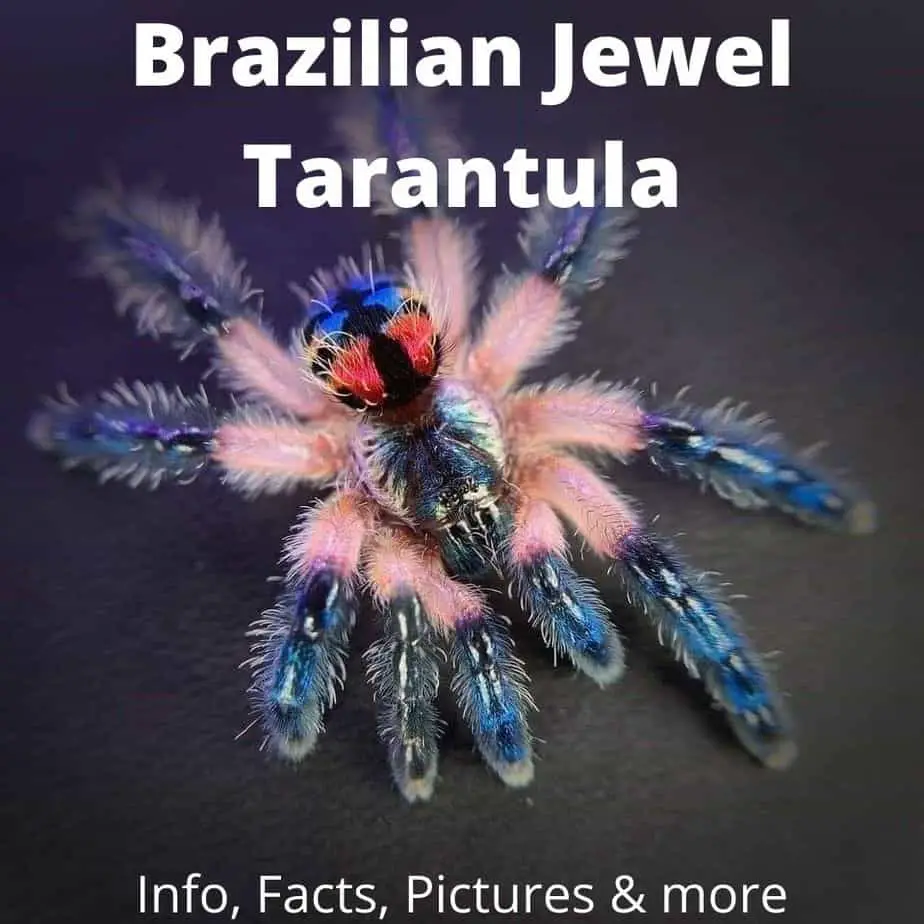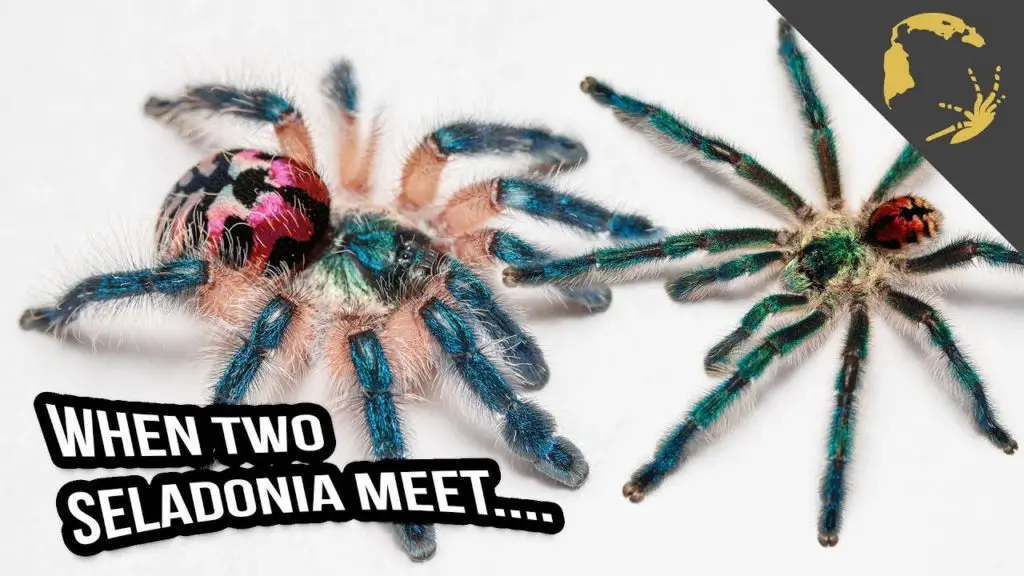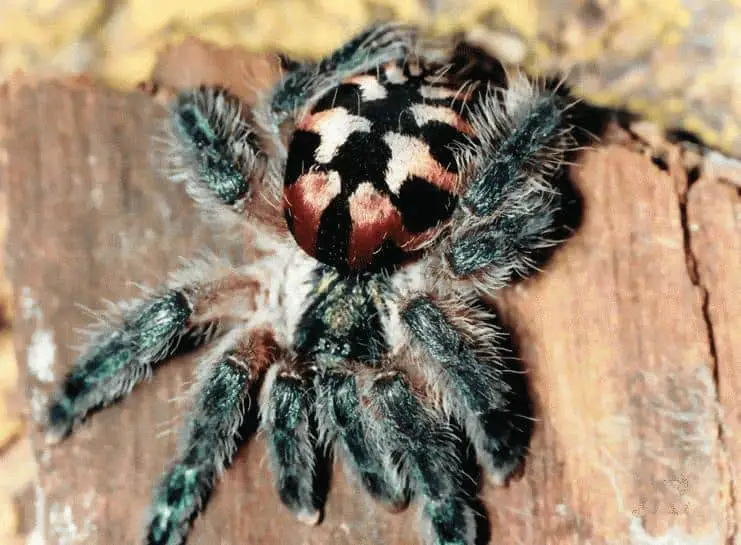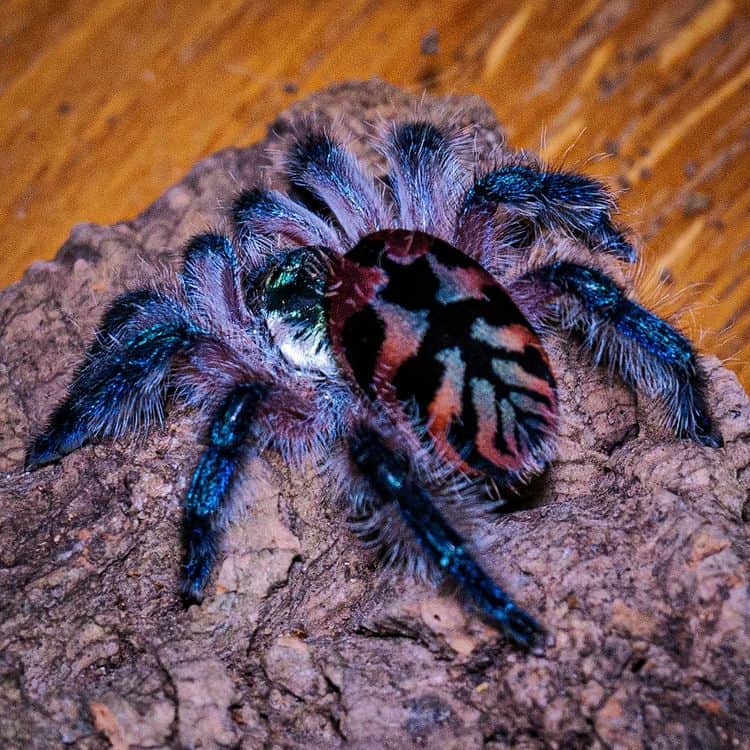The Brazilian Jewel Tarantula is a New World tarantula native to Brazil. It’s an arboreal trapdoor spider characterized by its colorful appearance. It’s adorned with blue, pink, red, and other colors and is without a doubt the prettiest and most colorful tarantula in the world.
This spider’s unique, colorful appearance has made it highly desired among hobbyists in the United States and elsewhere, but there’s a problem; the spider is technically illegal! More on that later.
While this tarantula is illegal to import as a pet, it’s still a fascinating creature that’s worth learning more about, so let’s dig in.

Brazilian Jewel Tarantula Fact Sheet
| Name of species | Typhochlaena seladonia |
| Family | Theraphosidae |
| Common Name | Brazilian Jewel Tarantula, BJT |
| Category | New World |
| Type | Arboreal |
| Native location | Brazil |
| Legspan | Females 2.5″, males 2″ |
| Lifespan | Males, 4 years. Females, 15 years. |
| Urticating hairs | Yes |
| Diet | Insects |
| Humidity | 75 to 85% |
| Temperature | 80 degrees Fahrenheit |
| Temperament | Docile |
Brazilian Jewel Tarantula overview
The Brazilian Jewel Tarantula is a relatively small arboreal spider from Brazil. Males typically only have a leg span of about 2″, while females have a leg span of about 2.5″. This is quite small compared to other New World species which often have leg spans larger than 6″.
They inhabit the Atlantic Rainforest where they live in trees. They create trapdoor webs in these trees in order to catch prey. Since they spend the majority of their lives in their trapdoor waiting for prey to come, they’re not a very active species. They prefer to let the prey come to them rather than the other way around.
Since this is a new world spider they have urticating hairs which they can kick then they feel threatened. Similar to many other New World species, they do not have very potent venom.
Appearance & Varieties

The Typhochlaena Seladonia is named Brazilian Jewel Tarantula because it’s the most colorful tarantula species on earth. Its carapace, legs, and abdomen all have a wide variety of different colors including blue, yellow, black, pink, red, and many others. They also have two rows of six spots on their dorsum.
As is the case with most spiders, male Brazilian Jewels are smaller than females. Males also have a very long embolus while females have a long, thin spermatheca. Additionally, males typically have longer legs but smaller abdomens than females.
This species grows at an average rate but since they’re so small compared to other tarantulas they reach their fully grown size quite quickly.
Behavior & Temperament

The Brazilian Jewel Tarantula is a relatively docile and calm spider. They do not tend to bite and prefer to run away from danger if possible. However, if they feel like they cannot escape and are in danger, they will bite. Luckily, their venom is not very potent and will not pose much harm to a human unless you’re allergic.
Since they’re New World Tarantulas, they also have urticating hairs. If they feel like you’re threatening them they can kick these hairs in your direction. These hairs are typically not dangerous, except if they land in your eye.
In the wild, these tarantulas build trapdoor webs in the trees. They then wait for their prey to come to them and ambush them.
Tarantulas do not really realize that they live in captivity, so they often retain the same behavior that they had in the wild. As such, this spider will spend a lot of time in hiding. This, combined with their small size, does not make them very good show spiders, despite their beautiful coloration.
Legality
While the Brazilian Jewel Tarantula is extremely beautiful and many hobbyists would love to add it to their collection, there is one problem: legality.
Unfortunately, there’s a situation where the Brazilian government has a law that no flora or fauna can be exported out of the country without prior governmental consent. For this tarantula species, this consent has never been given.
As a result, the U.S. government deems all Typhochlaena seladonias that are sold in the country to be offspring of smuggled tarantulas and has made them illegal. In other countries, the rules may be different.
This video by Tarantula Collective does a great job at explaining the situation:
However, even though you’re technically not permitted to buy, breed, or sell this species in the United States, many people still do it. In fact, many people are not even aware that it’s technically not allowed.
Furthermore, in other countries, the rules may be completely different. As such, we will still cover how to best care for this species.
Price
Due to the aforementioned legality issues, the Brazilian Jewel Tarantula is anything but cheap. It’s one of the rarest species on the market and the price reflects that.
It’s hard to find a breeder in the first place, but you can expect to pay between $600 and $1000 for one of these spiders if you do find one, depending on whether you buy a male or female, and sling or adult.
Brazilian Jewel Tarantula care
Enclosure size
Due to the species’ small size and sedentary nature, the Brazilian Jewel does not need a very big enclosure. What’s important to keep in mind when selecting an appropriate enclosure is that height is much more important than width, due to the fact that this spider is arboreal.
An enclosure that’s 8″ x 8″ x 12″ is sufficient to house this species without issue.
Foliage & Decoration
Since this tarantula is arboreal, you’ll need to simulate a forest environment. To do this, you can use a cork bark that takes up a large part of the enclosure. It will allow your eight-legged friend to create its famous trapdoor webs and will make them feel right at home.
Substrate
The Brazilian Jewel Tarantula is not a terrestrial spider, so it does not quite need as much substrate as other species. About 2 inches of moisture-retaining substrate is plenty.
Temperature & humidity
Since the BJT is native to the Brazilian rainforest it does best if you simulate those conditions. That means a temperature of around 70 to 80 degrees Fahrenheit and humidity between 75 and 85% are ideal. The enclosure should be humid, but should not feel overly misty or swampy.
If you’re struggling to keep the humidity high, an oversized water bowl will increase the humidity through evaporation. In addition, you can elevate the humidity levels by periodically spraying the substrate.
Molting
Whenever its exoskeleton is not large enough to accommodate its growing size, the BJT will shed it in a process called molting. This happens quite frequently, especially when they’re young and growing fast.
Before the molting process, they will typically refuse food and water for a few days and then shed their old skin. Do not disturb them while they are molting as this is a stressful period for them.
Feeding a Brazilian Jewel Tarantula

The Brazilian Jewel Tarantula is small, but it has quite a big appetite. It thrives on a diet that consists exclusively of insects.
This species is not much of a hunter, but they don’t need to be. Their trapdoor hunting strategy has worked for them for thousands if not millions of years and is very interesting to see in action.
Slings should be fed fruit flies until they grow into juveniles and are capable of eating larger prey such as pinhead crickets. Once they’re fully grown, they should be fed a small cricket twice a week. Gut-loading the insects is a good thing to do to ensure that your tarantula gets all the nutrients it needs.
Of course, no two spiders are the same. Some are bigger or more active and might need more food than others.
Health & Lifespan
The Brazilian Jewel Tarantula is a relatively healthy arachnid.
In captivity, they do not have much to fear and can easily live out their entire lifespan until they die of natural causes. The most threatening things to them in captivity are dehydration, mites, and the occasional parasite in their food. Fortunately, these problems are easy to prevent and deal with.
Brazilian Jewel females have a lifespan of up to 15 years while males typically only live for 4 years.
Brazilian Jewel Tarantula facts
- This species has had several name changes. Nowadays, the species is known as the Typhochlaena seladonia but it used to be known as the Mygale seladonia. From the first name until the name that is has now it had a total of 6 name changes!
- The BJT is a dwarf species. They have a leg span of only 2.5″ whereas most other Tarantulas can easily reach a leg span over 6″.
- Males have more urticating hairs than females
- It’s also known under the names Candy Shop spider and Jewel Toe Spider.
Final words
The Brazilian Jewel Tarantula is an absolute stunner of a spider. Their fancy colors make them one of the prettiest spiders in the world and because of that, they’re highly desired among collectors.
Do note though, that they’re very hard to get and that as a result, they’re very expensive. Nevertheless, their docile nature combined with their stunning colors make them an excellent choice if you can afford them!
- How Long Do American Eskimo Dogs Live? Important Factors and Care Tips - September 29, 2023
- Do American Bulldogs Need Grooming? Essential Tips and Care Guidelines - September 29, 2023
- Do Bengal Cats Enjoy Playing? Essential Tips for Keeping Them Active - September 29, 2023